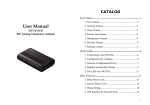Download MicroNet SP5001D User`s manual
Transcript
User’s Manual IP Telephony Gateway Model No.: SP5001C, SP5001D, SP5002A, SP5012A World Wide Web: www.micronet.com.tw ; www.micronet.info About this User’s Manual This User’s Manual gives users basic steps on installation and operation. Please read this manual chapter by chapter. Chapter 1. Introduction Introduce the IP Telephony Gateway to users in terms of feature, appearance, and application. Chapter 2. Startup Help user complete basic configuration. Chapter 3. Operation Show user how to use the device to process phone call and FAX. Chapter 4. Web Administration Provide command reference of Web Interface for advanced setting. Chapter 5. IVR/Keypad Management Provide instructions on configuring the IP Telephony gateway via Keypad on the phone set. Chapter 6. Specification List the specification of the gateway in detail. Online Upgrade Please refer to http://www.micronet.info/ for additional support. 1 Table of Content 1. ..Introduction.............................................................................................. 4 1.1 Key Features ................................................................................................ 5 1.2 Physical Description ..................................................................................... 6 1.3 Application.................................................................................................. 10 2. ..Startup .................................................................................................... 13 2.1 Login into the System ................................................................................. 13 2.2 Network Configuration................................................................................ 15 2.3 SIP Configuration ....................................................................................... 17 2.4 VPN Configuration...................................................................................... 19 2.5 DDNS ......................................................................................................... 21 3. ..Operation................................................................................................ 22 3.1 Make a Call ................................................................................................ 22 3.1.1 Make PSTN Call (SP5001D only) ................................................................. 22 3.2 Speed Dial / P2P call .................................................................................. 23 3.3 Call Forward ............................................................................................... 24 3.4 Call Hold / Call Waiting / Conference ......................................................... 25 3.5 FAX............................................................................................................. 26 4. ..Web Administration ............................................................................... 27 4.1 Phone Book ................................................................................................ 27 4.2 Phone Setting............................................................................................. 27 4.3 4.2.1 Call Forward .................................................................................................. 27 4.2.2 SNTP Settings............................................................................................... 27 4.2.3 Volume Settings ............................................................................................ 27 4.2.4 Block Settings................................................................................................ 28 4.2.5 Caller ID ........................................................................................................ 28 4.2.6 Dial Plan Setting............................................................................................ 28 4.2.7 Flash Time Setting......................................................................................... 30 4.2.8 Call Waiting Setting ....................................................................................... 30 4.2.9 T.38 (FAX) Setting ......................................................................................... 31 Network ...................................................................................................... 32 4.3.1 Status............................................................................................................. 32 4.3.2 WAN Settings ................................................................................................ 32 4.3.3 LAN Settings ................................................................................................. 32 4.3.4 DDNS Settings .............................................................................................. 33 4.3.5 VLAN Settings ............................................................................................... 33 4.3.6 PPTP Settings ............................................................................................... 34 2 4.4 4.3.7 DMZ * ............................................................................................................ 34 4.3.8 Virtual Server * .............................................................................................. 34 SIP Settings................................................................................................ 35 4.4.1 Service Domain ............................................................................................. 35 4.4.2 Port Settings.................................................................................................. 35 4.4.3 Codec Settings .............................................................................................. 35 4.4.4 Codec ID Settings ......................................................................................... 36 4.4.5 DTMF Setting ................................................................................................ 36 4.4.6 RPort Setting ................................................................................................. 36 4.4.7 Other Settings ............................................................................................... 37 4.5 NAT Trans. / STUN..................................................................................... 38 4.6 Others......................................................................................................... 39 4.6.1 Auto Config.................................................................................................... 39 4.6.2 ICMP Setting ................................................................................................. 39 4.6.3 PTT Setting ................................................................................................... 39 4.7 System Auth. .............................................................................................. 40 4.8 Save Change.............................................................................................. 40 4.9 Update........................................................................................................ 40 4.9.1 New Firmware ............................................................................................... 40 4.9.2 Default Setting............................................................................................... 41 4.10 Reboot........................................................................................................ 41 5. ..IVR / Keypad Management .................................................................... 42 6. ..Specification........................................................................................... 44 3 1. Introduction Micronet SP5001C, SP5001D, SP5002A and SP5012A IP Telephony Gateway is designed to connect standard telephone devices to IP-based telephony networks, providing users with high-quality VoIP service. SP5001C / SP5002A provides: ● 1/2 FXS port(s) for phone set, FAX machine, or PBX’s trunk SP5001D provides: ● 1 FXS port for phone set, FAX machine, or PBX’s trunk ● 1 PSTN port for PSTN lifeline that tranceives PSTN calls as backup even if VoIP fails. SP5012A provides: ● 1 FXS port for phone set, FAX machine, or PBX’s trunk ● 1 FXO port for PSTN line or PBX’s extension to make communication between PSTN and IP clients. With built-in router function, they offer internet access sharing to co-located PCs. The simple operation and configuration features are the most suitable for residential and SOHO applications. 4 1.1 Key Features z z z z z z z z z z z z z z Compliant with IETF SIP standards Provide 2 10/100M RJ-45 ports for WAN and LAN connection Support G.729a/b, G.711a/µ-law, and G.726 codecs Support up to 3 SIP service domains Support STUN and Outbound proxy for NAT traversal Support VAD, CNG, EC, and Adaptive Jitter Buffer Support FSK / DTMF caller ID display Support Call Hold / Call Waiting / Call Forward Support 3-way conference Provide phone address book and speed dialing function Transmit voice and FAX (T.38 and in-band) Support PPTP client for VPN Support IP ToS/DSCP, and 802.1q/p for QoS Easy management via WEB and IVR/keypad 5 1.2 Physical Description SP5001C: SP5001C Front Panel LED Status Description PWR On/Green Power On STATUS On/Amber Line Registered TEL On/Amber Phone set off-hook LAN On/Green Link On WAN On/Green Link On SP5001C Rear Panel --------------------------------------------------------------------------------------------------RESET Factory default button. Press and hold for 5 seconds to reset WAN RJ-45 port of 10/100M for connecting to modem LAN RJ-45 port of 10/100M for connecting to PC or hub/switch that connects PCs TEL RJ-11 port for connecting to phone set or PBX trunk --------------------------------------------------------------------------------------------------- 6 SP5001D: SP5001D Front Panel LED Status Description PWR On/Green Power On PSTN On/Amber PSTN mode / VoIP Unregistered TEL On/Amber Phone set off-hook LAN On/Green Link On WAN On/Green Link On SP5001D Rear Panel --------------------------------------------------------------------------------------------------RESET Factory default button. Press and hold for 5 seconds to reset WAN RJ-45 port of 10/100M for connecting to modem LAN RJ-45 port of 10/100M for connecting to PC or hub/switch that connects PCs TEL RJ-11 port for connecting to phone set or PBX trunk PSTN RJ-11 port for connecting to PSTN (lifeline) --------------------------------------------------------------------------------------------------- 7 SP5002A: SP5002A Front Panel LED Status Description PWR On/Green Power On TEL1 On/Amber Line Registered TEL2 On/Amber Line Registered LAN On/Green Link On WAN On/Green Link On SP5002A Rear Panel --------------------------------------------------------------------------------------------------RESET Factory default button. Press and hold for 5 seconds to reset WAN RJ-45 port of 10/100M for connecting to modem LAN RJ-45 port of 10/100M for connecting to PC or hub/switch that connects PCs TEL1 RJ-11 port for connecting to phone set or PBX trunk TEL2 RJ-11 port for connecting to phone set or PBX trunk --------------------------------------------------------------------------------------------------- 8 SP5012A: SP5012A Front Panel LED Status Description PWR On/Green Power On TEL On/Amber Line Registered LINE On/Amber Line Registered LAN On/Green Link On WAN On/Green Link On SP5012A Rear Panel --------------------------------------------------------------------------------------------------RESET Factory default button. Press and hold for 5 seconds to reset WAN RJ-45 port of 10/100M for connecting to modem LAN RJ-45 port of 10/100M for connecting to PC or hub/switch that connects PCs LINE RJ-11 port for connecting to PSTN or PBX extension TEL RJ-11 port for connecting to phone set or PBX trunk --------------------------------------------------------------------------------------------------- 9 1.3 Application SP5001C: ● 1 RJ-11 FXS port is provided for phone set or PBX's trunk line connection ● ● 2 RJ-45 ports of 10/100M are provided for WAN and LAN connection The IP telephony gateway can share Internet access with LAN clients SP5002A: ● 2 RJ-11 FXS ports are provided for phone set or PBX's trunk line connection ● ● 2 RJ-45 ports of 10/100M are provided for WAN and LAN connection The IP telephony gateway can share Internet access with LAN clients 10 SP5001D: ● 1 RJ-11 FXS port is provided for phone set or PBX's trunk line connection ● 1 RJ-11 PSTN port is provided to tranceive PSTN calls as backup even if VoIP fails ● ● 2 RJ-45 ports of 10/100M are provided for WAN and LAN connection The IP telephony gateway can share Internet access with LAN clients SP5012A: ● 1 RJ-11 FXS port is provided for phone set or PBX's trunk line connection ● 1 RJ-11 FXO port is provided for PSTN or PBX's extension connection, and for PSTN client to communicate with IP client ● ● 2 RJ-45 ports of 10/100M are provided for WAN and LAN connection The IP telephony gateway can share Internet access with LAN clients 11 VPN (Virtual Private Network) The IP telephony gateway series supports PPTP client for VPN function. It can establish VPN tunnel with PPTP server, and get access to the peer private network as if it is located in the same LAN. For special condition that SIP proxy server is located in the private network of CO site, the gateway can register, and request a phone call via the VPN tunnel. Please refer to the section 2.4 VPN Settings. 12 2. Startup 2.1 Login into the System The embedded web configuration allows you to use a web browser to manage the IP Telephony gateway. Step 1. Connect LAN port to your managing PC. Or, connect the gateway with PC by hub/switch. Step 2. Launch your web browser with http://192.168.123.1:9999/. Please configure IP address of PC with 192.168.123.x. Step 3. The Password screen now appears. Type “root” in the user name field and your password (none by default) in the password field. Step 4. Click on Login. Login Screen Step 5. After a successful login, you will see the screen System Information as shown below. 13 14 2.2 Network Configuration By default, the gateway is in NAT mode (router mode) and can share Internet access with PCs. Go to [ Network / WAN Settings ], and configure WAN setting according to actual condition. In default IP type of DHCP client, it requests necessary IP information from your ISP automatically. ----------------------------------------------------------------------------------------------------Note: Different ISPs require different methods of connecting to the Internet. Please consult your ISP to select right IP type (Fixed IP, PPPoE) of WAN. ----------------------------------------------------------------------------------------------------- 15 ----------------------------------------------------------------------------------------------------Parameter Description ----------------------------------------------------------------------------------------------------LAN Mode Bridge: pure VoIP gateway NAT: VoIP router IP Type Select Fixed IP, DHCP (default), or PPPoE IP IP address provided by ISP Mask Subnet mask provided by ISP Gateway ISP’s IP address gateway DNS Server1/2 IP address of primary/secondary DNS server MAC MAC address PPPoE Username User Name provided by ISP for the PPPoE connection Password Password provided by your ISP for the PPPoE connection ----------------------------------------------------------------------------------------------------When Router mode is disabled, the unit is just a pure VoIP gateway. In LAN mode, select Bridge to disable router mode. ----------------------------------------------------------------------------------------------------Note: 1. Please save and reboot the system to take effect. Go to [ Save Change ] to save configuration, and the system will reboot automatically. 2. Please unplug LAN port when LAN mode is Bridge. Just keep WAN port plugged. ---------------------------------------------------------------------------------------------------- 16 2.3 SIP Configuration Go to [ SIP Settings / Service Domain ]. Each port can be configured to register 3 different service domains. ----------------------------------------------------------------------------------------------------Parameter Description ----------------------------------------------------------------------------------------------------Phone No. Select specific port to configure Active Select “On” to activate User Name IP telephony number of the line Register Name User’s ID Register Password Password Domain Server Domain server IP Proxy Server SIP proxy IP and Port (default: 5060) <sip_proxy_ip>:<sip_proxy_port> Outbound Proxy Outbound proxy IP and Port <outbound_proxy_ip>:< outbound_proxy_port> Status Registered or not. ----------------------------------------------------------------------------------------------------Go to [ NAT Trans. / STUN Setting ] to set up STUN On, if necessary. 17 ----------------------------------------------------------------------------------------------------Note: Please save and reboot the system to take effect. Go to [ Save Change ] to save configuration, and the system will reboot automatically. ----------------------------------------------------------------------------------------------------- 18 2.4 VPN Configuration IP telephony gateway supports PPTP client for VPN. It can establish VPN tunnel with PPTP server. Go to [ Network / PPTP Settings ], and set PPTP server address, and authentication information (username, password). ----------------------------------------------------------------------------------------------------Parameter Description ----------------------------------------------------------------------------------------------------PPTP Server Set IP address of PPTP server PPTP Username Set username for authentication to set up VPN tunnel PPTP Password Set password for authentication to set up VPN tunnel ----------------------------------------------------------------------------------------------------Click on Submit, and save to take effect. 19 After tunnel is established, the gateway gets one private IP address (Interface 2) from PPTP server as shown in [ Network / Status ]. 20 2.5 DDNS DDNS allows you to map the static domain name to a dynamic IP address. You must get an account, password and your static domain name from the DDNS service providers. ● DDNS makes the gateway accessible for other client to call in P2P (peer-to-peer) mode, when the IP address is dynamic. ● DDNS setting is not necessary when IP call is tranceived via service domain only. Go to [ Network / DDNS Settings ] and set up DDNS. ----------------------------------------------------------------------------------------------------Note: Please save and reboot the system to take effect. Go to [ Save Change ] to save configuration, and the system will reboot automatically. ----------------------------------------------------------------------------------------------------- 21 3. Operation 3.1 Make a Call By default, call is sent via the first registrar server only. The telephone number of clients in the second/third service domain will be not accessible. Make a Call Press <telephone_number> + # ----------------------------------------------------------------------------------------------------Note: ● Once the first registration fails, the second realm will be activated. ● The gateway can always receive incoming call from the client of either registered service domain. ● The gateway is accessible for P2P client to dial the configured telephone numbers. DDNS setting is necessary when WAN IP address is dynamic. ----------------------------------------------------------------------------------------------------- 3.1.1 Make PSTN Call (SP5001D only) SP5001D provides 1 RJ-11 port for PSTN lifeline, and can tranceive PSTN calls even if VoIP fails. VoIP Unregistered: ● Make PSTN Call Press <pstn_number> VoIP Registered: ● Press 0* to switch to PSTN mode ● press <pstn_number> 22 3.2 Speed Dial / P2P call Speed dial Press <index> + # Go to [ Phone Book / Speed Dial Setting ]. User can create 10 entries (0~9) in Speed Dial Phone List. ----------------------------------------------------------------------------------------------------Parameter Description ----------------------------------------------------------------------------------------------------Position Speed dial index, 0~9 Name Alias of the specific entry URL It can be… ● Telephone number of registered client ● PSTN number (if server provides off-net call ) ● Address-like URL (peer-to-peer call) <telephone_number> @ <peer_device_ip_address> <pstn_number> @ <peer_fxo_gateway_ip_address> ----------------------------------------------------------------------------------------------------- 23 3.3 Call Forward Go to [ Phone Setting / Call Forward ]. There are 3 selections in Forward type. User must select the condition under which to forward calls. ----------------------------------------------------------------------------------------------------Parameter Description ----------------------------------------------------------------------------------------------------All Forward Forward the call in any conditions ● Off: call forward disabled. ● On/IP: Call forward to IP. It disables other 2 forwarding types. ● PSTN: Call forward to PSTN. It disables other 2 forwarding types. Busy Forward When the phone is in busy status, forward the call ● Off: call forward disabled. ● On: IP Call forward to IP. No Answer Forward When the phone is not picked up for a period of time, forward the call ● Off: call forward disabled. ● On/IP: Call forward to IP. ● PSTN: Call forward to PSTN. Name Alias of the forwarding number URL Destination number (that call is forwarded to) or address-like URL. It can be… ● Telephone number of registered client ● PSTN number (if server provides off-net call ) ● Address-like URL (Calling party has to support P2P call.) ----------------------------------------------------------------------------------------------------- 24 3.4 Call Hold / Call Waiting / Conference The IP telephony gateway provides telephony features, as call hold, call waiting, and 3-way conference. Call Hold: Hold a existing call Call waiting: Hold a existing call, and answer a new incoming call 3-way conference: Talk with other 2 party in the same session. ● ● ● Call Hold ● Press Hook or Flash to hold ● Press Hook or Flash again to resume Call Waiting ● Voice “do-do” informs of a new call when a talk is in progress ● Press Hook or Flash to hold the existing call, and proceed to the new call ● Press Hook or Flash to switch between two calls 3-way ● Establish a call Conference ● Press Hook or Flash to hold the existing call ● Hear a dial tone and dial to establish another ● Press Hook or Flash again ----------------------------------------------------------------------------------------------------Note: ● Adjust “Flash Time” to make Hook key work, if necessary. Set up the time to suit the connected phone set. Please refer to the section 4.2.7 Flash Time Setting. ● Call waiting function has to be enabled. Please refer to the section 4.2.8 Call Waiting Setting. ----------------------------------------------------------------------------------------------------- 25 3.5 FAX Send FAX ● Press <fax_number> to connect fax machine ● Start to send FAX T.38 FAX: Go to [ Phone Setting / T.38 (FAX) Setting ]. Click on “On” and enable T.38 to tranceive FAX over IP. In-band FAX: disable T.38 and choose G.711 codec as top priority. Please refer to the section 4.4.3 Codec Settings. ----------------------------------------------------------------------------------------------------Note: When sending in-band FAX (in G.711), please disable T.38 and choose G.711 codec as top priority. Please refer to the section 4.4.3 Codec Settings. ----------------------------------------------------------------------------------------------------- 26 4. Web Administration 4.1 Phone Book Please refer to the section 3.2 Speed Dial / P2P call. 4.2 Phone Setting 4.2.1 Call Forward Please refer to the section 3.3 Call Forward. 4.2.2 SNTP Settings User can set up the primary and second SNTP Server IP Address, to get the date/time information. 4.2.3 Volume Settings User can set up the Handset Volume, Ringer Volume, and the Handset Gain. ● ● ● Handset Volume: adjust the volume that you hear from the handset. Ringer Volume: adjust the ringer volume of phone set Handset Gain: adjust the volume that the gateway sends out to the other side. 27 4.2.4 Block Settings User can set up the gateway to block incoming calls and the period. 4.2.5 Caller ID User can set the device to show Caller ID in your PSTN Phone. The gateway supports FSK and DTMF. 4.2.6 Dial Plan Setting User can set dialing plan and timeout to send a phone call after dialing number is input. 28 ----------------------------------------------------------------------------------------------------Parameter Description ----------------------------------------------------------------------------------------------------Replace Prefix code On: enable “Replace rule” Off: disable “Replace rule” Replace rule Replace matched prefix with another Dial Plan If dialed numbers match the rule, numbers is sent out. If not, numbers would not be sent out. Plan with prefix “0” is invalid Auto Prefix Prepend the prefix before the dialed number is sent out Prefix Unset Plan Auto prefix is ignored when matching unset prefix Set up timeout to send a phone call after dialing number is input without pressing “#” ----------------------------------------------------------------------------------------------------Auto Dial Time Example: Replace Rule: 001 + 006 + 009 → 005 Input Sent out 001-6601 005-6601 006-5211 005-5211 009-4644 005-4644 Dial Plan: *xx + #xx + 11x + xxxxxxxx Rule Allowable input number *xx *01, *02, *15, *89, … #xx #11, #28, #96 11x 111, 112, 113, ..., 119, 110 xxxxxxxx Any 8-digit number, 12345687, 97856412, … 29 * means: keypad* on the phone x means: digit 0, 1, 2~9 # means: keypad # on the phone + means: or Auto prefix: 02 (0000~9999) Input Sent out 22183656 02-22183656 82265630 02-82265630 Prefix Unset Plan: 1 + 0 + xxxxxx ● With prefix “0”, auto prefix “02” is not prepended to dialing number ● With prefix “1”, auto prefix “02” is not prepended to dialing number ● With 6-digit number, auto prefix “02” is not prepended to dialing number Auto Prefix Input Sent out 02 0075 0075 02 1075 1075 02 2075 02-2075 02 22075 02-22075 02 222075 222075 4.2.7 Flash Time Setting User can set up “Flash Time” to detect flash signal initiated by pressing Hook or Flash key. 4.2.8 Call Waiting Setting User can enable Call Waiting function. 30 4.2.9 T.38 (FAX) Setting Please refer to the section 3.5 FAX. 31 4.3 Network 4.3.1 Status User can check the current Network setting. 4.3.2 WAN Settings Please refer to the section 2.2 Network Configuration. 4.3.3 LAN Settings User can configure for LAN clients. 32 ----------------------------------------------------------------------------------------------------Parameter Description ----------------------------------------------------------------------------------------------------IP IP address of LAN port. Default gateway IP of LAN clients in the local network Mask Subnet mask MAC MAC address DHCP Server “On” means DCHP server enabled. By enabling the DHCP server, the router will automatically give your LAN clients an IP address Start/End IP The IP range is released by DHCP Lease Time Time period that the DHCP lends an IP address to your LAN clients ----------------------------------------------------------------------------------------------------- 4.3.4 DDNS Settings Please refer to the section 2.5 DDNS. 4.3.5 VLAN Settings User can configure VLAN and prioritization respectively for voice and data packets. 33 4.3.6 PPTP Settings Please refer to the section 2.4 VPN Configuration. 4.3.7 DMZ * Open another page http://192.168.123.1:9999/dmzset.htm. With the function enabled, the gateway will re-direct all packets going to your WAN port IP address to a particular IP address in your LAN. * will be available in the later version. 4.3.8 Virtual Server * Open another page http://192.168.123.1:9999/vsset.htm. With the function enabled, it allows you to re-direct a particular service port number (from the Internet/WAN Port) to a particular LAN IP address and its service port number. * will be available in the later version. 34 4.4 SIP Settings 4.4.1 Service Domain Please refer to the section 2.3 SIP Configuration. 4.4.2 Port Settings User can set up SIP and RTP ports. 4.4.3 Codec Settings User can set up the Codec priority, RTP packet length, and VAD function. Please follow service provider’s suggestion to configure. 35 4.4.4 Codec ID Settings User can set up codec ID for different codec. This ID represents the codec used to encode data in the Track. 4.4.5 DTMF Setting User can set up the method of DTMF transmission: In-band, RFC2833, or SIP Info. 4.4.6 RPort Setting User can set up the RPort Enable/Disable. “RPort” is an extension to SIP for 36 Symmetric Response Routing. This behavior is not desirable in many cases. Please configure it according to your service provider. 4.4.7 Other Settings User can set up the Hold by RFC, Voice/SIP QoS and SIP expire time in this page. ----------------------------------------------------------------------------------------------------Parameter Description ----------------------------------------------------------------------------------------------------Hold by RFC Enable or disable Voice QoS (1-63) Assign a specific value for the first 6 bits of the IP ToS/DS (DiffServ) field in the Voice (RTP) packet header. SIP QoS (1-63) Assign a specific value for the first 6 bits of the IP ToS/DS (DiffServ) field in the Voice (RTP) packet header. ----------------------------------------------------------------------------------------------------NOTE: ● The function can discriminate the IP DSCP of the DS field in the IP packet header, and map each Code Point to a corresponding egress traffic priority. ● Junction devices (switch or router), within a converged network of voice and data, should support TOS / DiffServ to identify and prioritize voice traffic (QoS higher than 0) over others (QoS= 0). ● Setting Voice/SIP QoS as 46, voice is transmitted to Internet in the service class of 37 EF (Expedited Forwarding). ----------------------------------------------------------------------------------------------------SIP expire time the time used to inform proxy server of the valid duration of registration information. ----------------------------------------------------------------------------------------------------- 4.5 NAT Trans. / STUN Please refer to the section 2.3 SIP Configuration. 38 4.6 Others 4.6.1 Auto Config User can disable Auto Configuration or enable the function by TFTP/FTP. Please contact with your service provider for necessary information. 4.6.2 ICMP Setting User can set the gateway to reply ICMP echo request or not. Setting this function to “ON”, you will get reply when you PING this gateway. Setting this function to “Off”, you get no reply when you PING this gateway. 4.6.3 PTT Setting Select the PTT setting for FXS interface by different country. When you finished the setting, please click on the Submit button. 39 4.7 System Auth. Change system login name and password. 4.8 Save Change Click on the Save button. The system will automatically restart and the new setting will take effect. 4.9 Update 4.9.1 New Firmware User can upgrade the system via TFTP or HTTP in this page. Please upgrade the firmware by the following steps: ----------------------------------------------------------------------------------------------------Parameter Description ----------------------------------------------------------------------------------------------------Method Upgrade via HTTP or TFTP Code Type Select the firmware code type, Risc or DSP code. File Location Click on the Browse button to locate the firmware file. Or you can type the correct path and the filename in the field. TFTP Server IP address of TFTP server ----------------------------------------------------------------------------------------------------40 Click on the Update button to start upgrading. 4.9.2 Default Setting Click on the Restore button. Then, the system will restore factory default setting and automatically restart again. Changed network and SIP setting will be removed. 4.10 Reboot Press the reboot button. The system will restart automatically. 41 5. IVR / Keypad Management You can use the PSTN phone keypad to operate the IP Telephony gateway. Please follow the instruction to configure. IVR Action IVR Menu Parameter(s) Notes Choice Dial out from PSTN Line 0# None Unlock keypad setting #190# None Reboot #195# None Factory Reset #198# None Check WAN IP Address #126# None Check LAN IP Address #120# None Check IP Type #121# None Check the Phone Number #122# None Check Network Mask #123# None Check Gateway IP Address #124# None Check Primary DNS Server Setting #125# None Check Firmware Version #128# None Set DHCP client #111# None Set Static IP Address #112xxx*xxx*x xx*xxx# Enter IP address using numbers on the telephone keypad. 42 Press 0# can pass relay to PSTN Line, user can dial out from PSTN Line. (SP5001D only) After you unlock keypad setting, then you may configure the ATA. After you hear “Option Successful,” hang-up. The system will reboot automatically. System will automatically Reboot. WARNING!! ALL “User-Changeable” NONDEFAULT SETTINGS WILL BE LOST! This will include network and service provider data. IVR will announce the current WAN IP address of the gateway. IVR will announce the current LAN IP address of the gateway. IVR will announce if DHCP in enabled or disabled. IVR will announce current in use VoIP number. IVR will announce the current network mask of the gateway. IVR will announce the current gateway IP address of the gateway. IVR will announce the current setting in the Primary DNS field. IVR will announce the version of the firmware running on the gateway. The system will change to DHCP Client type DHCP will be disabled and system will change to the Static IP type. Use the * (star) key when entering a decimal point. Enter value-using numbers on the telephone keypad. Use the * (star) key when entering a decimal point. Enter IP address using numbers on the telephone keypad. Use the * (star) key when entering a decimal point. Enter IP address using numbers on the telephone keypad. Use the * (star) key when entering a decimal point. 1:G.711 u-Law, 2: G.711 a-Law, 3: G.723.1, 4: G.729a, 5: G.726 16K, 6: G.726 24K, 7: G.726 32K, 8: G.726 40K, Set Network Mask #113xxx*xxx*x xx*xxx# Set Gateway IP Address #114xxx*xxx*x xx*xxx# Set Primary DNS Server #115xxx*xxx*x xx*xxx# Set Codec #130+[1-8]# Set Handset Gain #131+[00~15]# Handset Gain from 0~15 Set Handset Volume #132+[00~12]# Handset Volume from 0~12 43 Must set Static IP first. Must set Static IP first. Must set Static IP first. You can set the codec you want to the first priority. You can set the Handset gain to proper value, default is 6. You can set the Handset volume to proper value, default is 10. 6. Specification Model SP5001C SP5001D Standard Telephone Port SP5002A SP5012A IETF SIP (RFC3261) 1 FXS 1 FXS 2 FXS 1 FXS 1 PSTN (lifeline) Ethernet Port 2 10/100M ports for WAN and LAN connection Voice Codec: 1 FXO ● G.711: 64k bit/s (PCM) ● G.726: 16k / 24k / 32k / 40k bit/s (ADPCM) ● G.729A: 8k bit/s (CS-ACELP) ● G.729B: adds VAD & CNG to G.729 CNG, EC (G.168), VAD Adaptive Jitter Buffer Gain (Voice Volume) Settings Provide Call Progress Tone DTMF In-band, SIP Info, RFC2833 Telephony Speed dial (10 sets) Call Forward / Call Hold / Call Waiting 3-way Conference Caller ID Display (DTMF / FSK) Call Block (Do Not Disturb) SIP Server Registrar Server (3 SIP accounts) Outbound proxy QoS IEEE802.1q/p, VLAN & Port prioritization IP ToS / DSCP Router NAT, VPN (PPTP client) DMZ*, Virtual Server* NAT Traversal STUN Networking Static assign, PPPoE, DHCP Management Web / Keypad (IVR) Environment Temperature: 0 - 40 degree C Humidity: 10% to 90% Power Supply 12VDC, 1A Emission CE * will be available in the later version. Date: 2006 / 05 / 10 44






















































